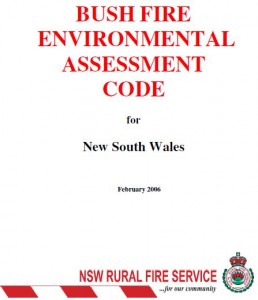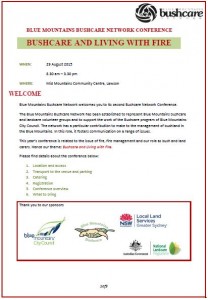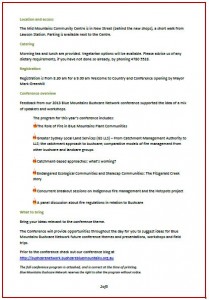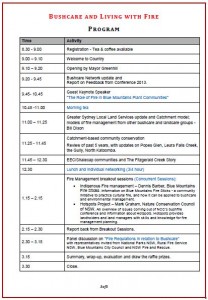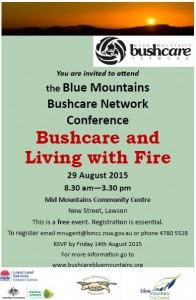Category Archives: Conferences
Conference 2015 Information Update
Here are some links to information available from Rural Fire Service that are relevant to the Bushcare and Living with Fire topic of our upcoming conference.
General Fact Sheets:
http://www.rfs.nsw.gov.au/resources/factsheets
Including …
Publications relating to Hazard Reduction, including 10/50 Code and Asset Protection Zones
http://www.rfs.nsw.gov.au/resources/publications/hazard-reduction
And how RFS and others deal with environmental issues in hazard reduction
http://www.rfs.nsw.gov.au/resources/publications/hazard-reduction/bushfire-environmental-assessment
Conference 2015 – To Get You Started
Background and General Information on Fire and The Environment
Several people from Blue Mountains organisations attended the NCC Conference in May. Some of the presentations have been selected as particularly interesting; brief descriptions and links are listed below; note that some of the papers are quite large download size.
You might find some of the opinions controversial or confronting!
Nature Conservation Council of NSW 10th Biennial Bushfire Conference 26-27 May 2015, Surry Hills, Sydney
NCC Conference papers and links
General link
http://www.nature.org.au/healthy-ecosystems/bushfire-program/conferences/
Abstracts booklet can be downloaded at
http://www.nature.org.au/media/2216/bushfire-conference-abstracts-program-may2015.pdf
Links specific to a selection of papers
Opening address, Kate Smolski
CEO, Nature Conservation Council NSW
“ … Good fire-management policy and practice could include both effective risk mitigation and positive environmental-management outcomes, and those two things did not have to be mutually exclusive.”
http://www.nature.org.au/media/2247/address-opening-kate-smolski-ncc.pdf
Opening address – Using fire for community and environmental outcomes
Robert Quirk
New South Wales Office of Environment and Heritage, National Parks and Wildlife Service
In the opening address Robert Quirk asserts that NPWS is fundamentally committed to conserving biodiversity through the use of fire in our lands through ecological burning and for the protection of conversation and of natural cultural heritage values including threatened species both on and off Park and Reserve. “ … We’re talking at this gathering about the use of fire for community and environmental outcomes and one of the aspects of this I want to touch on briefly is the change of the Service from fire fighters to fire lighters.”
http://www.nature.org.au/media/2251/address-opening-rob-quirk-oeh-npws.pdf
Setting the scene: climate change and the changing fire risk
Professor Lesley Hughes
Macquarie University, Climate Council of Australia
The paper explores “… the multiple ways in which climate change can affect fire risk. It can affect all four major factors contributing to fire risk – ignitions, fuel load, fuel condition and weather. It can affect ignitions, not in terms of the number of 10-year-olds with a box of matches that go out and light fires, but in terms of lightning strikes. Lightning increases as the weather gets warmer and more humid. Climate can affect fuel load in several ways – if we get a wetter summer, for example, we get more vegetation, if we get a drier summer, we can have less vegetation. Fuel condition, however, is more dependent on the weather in the preceding few months, up and down, The one factor where climate change has a very clear, directional impact, is bushfire weather… As we get more extreme high temperatures, we also get more extreme bushfire weather.”
http://www.nature.org.au/media/2227/1_lesley-hughes-climate-change-and-fire-risk.pdf
When is burning good for the bush?
Naomi Rea
Mulga Data Services
The paper provides possible research areas and considerations that might inform a balanced approach for fire in ecological restoration, looking at both risks and benefits.
http://www.nature.org.au/media/2252/6_naomi-rea-when-is-burning-good-for-bush.pdf
Fuel load, structure and flammability of weeds as key factors in Australian weed classification frameworks
Felipe Aires
University of Sydney
The paper outlines a thesis. The main idea behind thesis “…was that there is already a lot of knowledge about each one of the components forming fire regimes for each type of native fuel types. There are fairly good ways to predict fire behaviour and intensity in native fuels and the empirical models keep being improved.
However, as the fuels shift from native to invasive species the cycle changes and the limited knowledge on fire behaviour of these emergent fuel types may have many practical consequences.”
http://www.nature.org.au/media/2239/15_felipe-aires-fuel-flammability-and-weed-classification.pdf
The State Mine Fire, October 2013 – Patterns of vegetation recovery
Roger Lembit
Gingra Ecological Surveys
Roger Lembit’s study includes Newnes Plateau Shrub Swamp. “… There are other interesting habitats surrounding sandstone formations known as pagodas.”
http://www.nature.org.au/media/2244/22_roger-lembit-state-mine-fire-recovery.pdf
Thanks to Jenny Hill for compiling this list.
Conference 2015 Welcome Pack
Now Available!
The official Blue Mountains Bushcare Network Conference 2015 “Welcome Pack” has been published today.
This give registered attendees all the information needed to get to and enjoy this get-together for Bushcare volunteers, professionals and like-minded community members.
For a printable version, download via this link Conference welcome pack Aug
Can’t spare the whole day to attend? Come for any session or time you can spare – but if you would like to enjoy lunch with us, you MUST book your place.
For booking details see the invitation poster below.
Conference 2015 Invitation Launched
New Today!
The invitation “poster” is now available on-line – download “invitation conference August”
This shows the details – if you would like a printable version, save the pdf version via this link invitation conference August
Conference 2015 – Bushcare and Living with Fire
Bushcare Network Conference 2015 “Bushcare and Living with Fire”
29th August 2015. Put it in your diary now!
Thoughts and Concepts to Get You Started.
As a lead up to the upcoming Bushcare Conference the Blue Mountains Bushcare Network has put together a list of interesting web sites as a primer in the lead up to the Conference.
The Nature Conservation Council of NSW (NCCNSW ) hosted a Bushfire Conference in May 2015 “Fire & Restoration“
http://www.nature.org.au/healthy-ecosystems/bushfire-program/conferences/ (webpage)
A list of speakers & topics from the Conference can be found at http://www.nature.org.au/media/2176/fire-restoration-conference-program-nccmay2015.pdf
(435Kb)
2013 NCC Bushfire Conference abstracts.
Here are links to the reports from the previous NCC conference. http://www.nature.org.au/media/2014/abstracts-booklet-ncc-bushfire-conf2013-part1of2.pdf (3.3Mb) and
http://www.nature.org.au/media/2015/abstracts-booklet-ncc-bushfire-conf2013-part2of2.pdf (2.5Mb)
A most informative Booklet on the Impact of Fire on our Native Vegetation in the Blue Mountains is Vegetation, Fire And Climate Change in the Greater Blue Mountains World Heritage Area by Kate Hammill & Liz Tasker, which can be viewed at http://www.environment.nsw.gov.au/resources/protectedareas/deccw20100941.pdf (10Mb)
Yellomundee Firesticks Project
An interesting video on the Yellomundee Firesticks Project can be found at https://vimeo.com/104977827
Blue Mountains Firesticks Program
And here is a link to a paper by Oliver Costello. Oliver works for NCC & helped Den Barber set up the Blue Mountains Fire Sticks program.
http://www.nature.org.au/media/1742/ocostello-write-up_final.pdf (3Mb)
Hotspots Fire Project
Finally for now, here is a link to the NCC Hotspots Fire Project. http://hotspotsfireproject.org.au/

